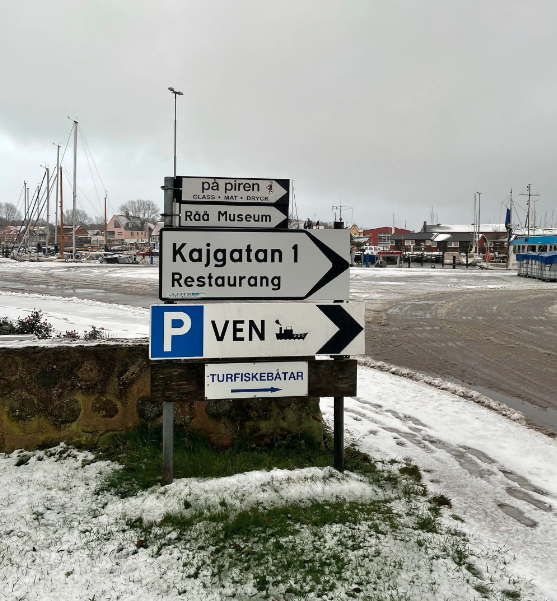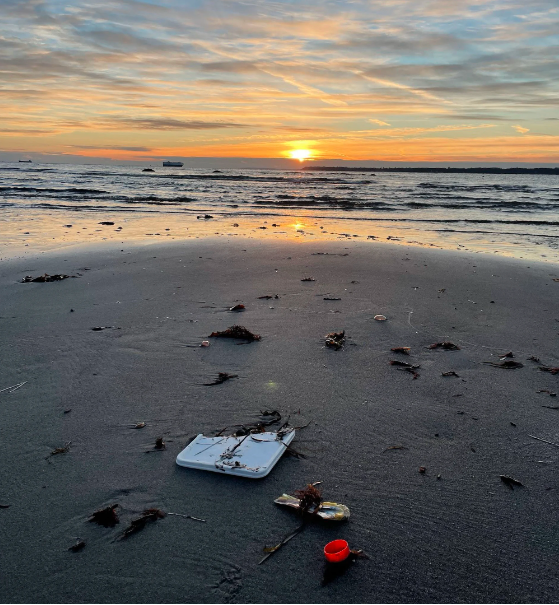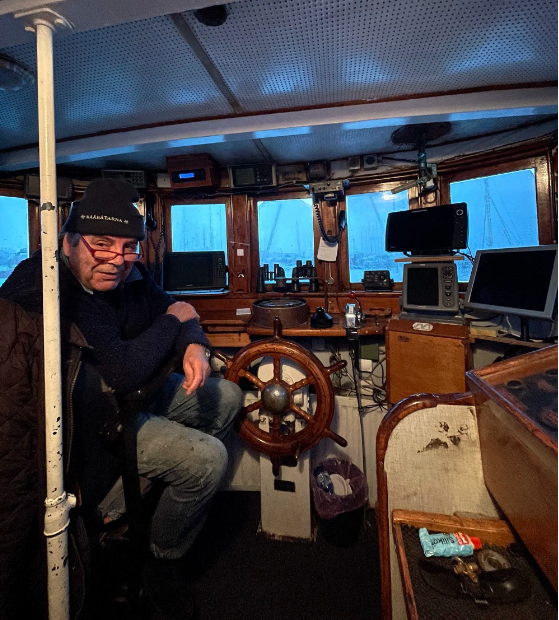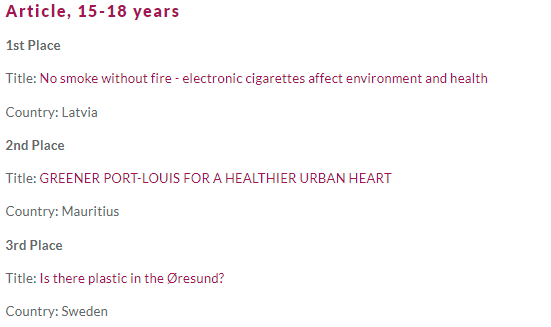YRE Competition 2022
3rd Place - Article
15-18 years old
By Lina Persson Giolitti
Plastic is a common and important material in our daily lives. It has many useful features and can help solve many problems and needs. The material is cheap and can for example be used for hospital supplies. However, the way we humans use and consume plastic today is in many cases not sustainable.
Guidance at Råå harbor. Photo: Lina Persson Giolitti
The rain whips against my cold and red cheeks as I walk towards Råå harbor. It is a dark and cold December afternoon. The masts of the sailing boats are whistling and the sea is stormy. I stand behind a fishing shelter to protect myself from the heavy rain.
After a while, I see Thomas Lövström, the manager of Rååbåtarna, a company that runs trips to the pearl of Öresund, the island of Ven, as well as other fishing trips. Lövström greets me to his boat Siam and we sit down in the cold and dark wheelhouse. Outside, the rain is pounding on the boat's small windows. It smells of old wood and tar - just like fishing boats should smell.
– I see a lot of plastic along the beaches when I go out with my boat and not so much out on the ocean. However, there is more plastic than we humans can see. A lot of it is microplastic, and unfortunately many marine animals are affected by it. Not to forget, it also affects us further up in the food chain, says Lövström.
People have generally become more aware of what is thrown into nature. However, there is still room for improvement, but things are moving in the right direction. It's probably a lot about education, learning at an early age that it's wrong to throw plastic into nature. Many preschools also have 'litter picking days' and I think that's a good concept because then the children learn from each other and can spread the word, says Lövström.
THE CONSEQUENCES OF PLASTIC IN NATURE
All the plastic that ends up in our nature has an impact on the climate, the environment and not to mention all living creatures. Most of the plastic that ends up in the ocean is thrown on land by humans and carried by rain and wind into the ocean. The plastics that end up in the ocean are mostly disposable items. The plastic breaks up into smaller pieces, leaving microplastics in the ocean. It takes a long time for the plastic to decompose and is therefore very dangerous for nature and animals. Compared to a paper bag that takes about 1 month to break down, it takes 10-20 years for a plastic bag to break down into microplastics.
Did you know that:
80% of plastic pollution in the sea comes from land while the remaining 20% comes from fishing and marine activities.
60% of all whales have plastic in their stomach.
Every fourth cod fished outside Norway contains plastics.
Source: Greenpeace
– I believe and hope that plastic will decrease in the future given we start reducing our use of it. This is evident in today's society with more use of paper straws and paper bags. When compared to other countries in the world, Sweden is a very clean country. It is honestly frightening to see how much plastic there is in some countries, says Thomas.
- Thirty years ago, I caught a big cod in the Sound and when I filleted it, it had a Donald Duck plastic cup in its stomach. It has also happened that a plastic bag got stuck in the boat's propeller. After those two incidents, I asked myself “where is this world going?”. I could never imagine this to happen because for me the Öresund feels like a clean ocean - but apparently, there is plastic that we do not see or know about either, says Lövström.
Plastic on a beach along Öresund. Photo: Lina Persson Giolitti
PORPOISES AND TUNA IN ÖRESUND
– Apart from the plastic, Öresund has become much cleaner. One sign of that is that there have been lots of porpoises this summer. Tuna have also shown up and they are also very large, between 2-3 meters, and can weigh around 400kg. It is incredibly fun to watch because I believe it is a sign of a healthy Öresund. Given this, we also were completely booked during the summer by many families with children. Our industry was one of the few to benefit from the corona pandemic. Fresh air and distance were probably what kept us from getting hit. People enjoyed exploring local places when flights were not heading for warmer climes. However, I would like to emphasize that it is difficult to work in an industry where nature decides. You never know what will happen, Thomas explains.
Thomas Lövström in the wheelhouse of the boat Siam. Photo: Lina Persson Giolitti
WHAT CAN YOU DO YOURSELF?
One person cannot do everything, but everyone can do something to reduce plastic in nature. Even small actions have a big impact. One of several important things you can do to reduce plastic in the ocean is to recycle it. Even though we Swedes have become much better at sorting waste, there is still a lot of plastic that does not reach the recycling stations and may instead end up in our oceans. Using old plastic to make new plastic is both environmentally friendly and reduces the amount of plastic in the ocean. Our oceans are full of microplastics that are invisible to the naked eye. Microplastics that have been loosened from washing clothes, run down drains and end up in oceans. Therefore, airing and using a cloth can be the most environmentally friendly alternative to washing your clothes. Buying clothes second-hand is also environmentally friendly as it reuses goods, thus saving the manufacturing process and the energy to create new ones. Buying second-hand clothes, therefore, reduces microplastics in the ocean. The first four washes of a new item of clothing is the most environmentally damaging, which does not happen if you buy used clothes.
The ocean is an important source for our everyday life. Without the ocean, we will not get food from fish, and it will be more difficult to transport goods. It is therefore particularly important that we take care of our ocean and what is thrown into it. Because without a healthy and thriving ocean, our lives will become complicated.
REFERENCES:
Greenpeace Sverige, Plast i haven: fakta och konsekvenser, published 2021-06-22 https://www.greenpeace.org/sweden/nyheter/47646/plast-i-haven-fakta-och-konsekvenser/?gclid=CjwK CAiAs92MBhAXEiwAXTi25-eL4ud5C6wwU-xQ_en5wF9Qw9c7TF3EzVvO6oGwc5x0AqFy5RqDjBo CiGkQAvD_BwE (taken information: 2021-12-03)
Håll Sverige rent, Ingenting försvinner- allt finns kvar https://hsr.se/artiklar/nedbrytningstider (taken information: 2021-12-10)
Naturskyddsföreningen, 9 sätt att slåss mot plasten i haven, published 2021-02-25 https://www.naturskyddsforeningen.se/artiklar/9-satt-att-slass-mot-plasten-i-haven/ (taken information: 2021-12-03)
Naturskyddsföreningen, plast i havet, published 2021-02-24 https://www.naturskyddsforeningen.se/artiklar/plast-i-havet/ (taken information: 2021-12-06)
Interview with Thomas Lövström, 1 December 2021
DISSEMINATION
School's Social Media Pages:
https://www.facebook.com/campeonfrigymnasium
https://instagram.com/campeonhbg
National Operator Organization website:
http://ungareportrarthemagazine.se/aktuellt/finns-det-plast-i-o%cc%88resund/
https://hsr.se/nyheter/helsingborgselev-vinner-reportageresa-till-kenya
National Operator Organization Social Media Pages:
https://www.facebook.com/UngaReportrar/




